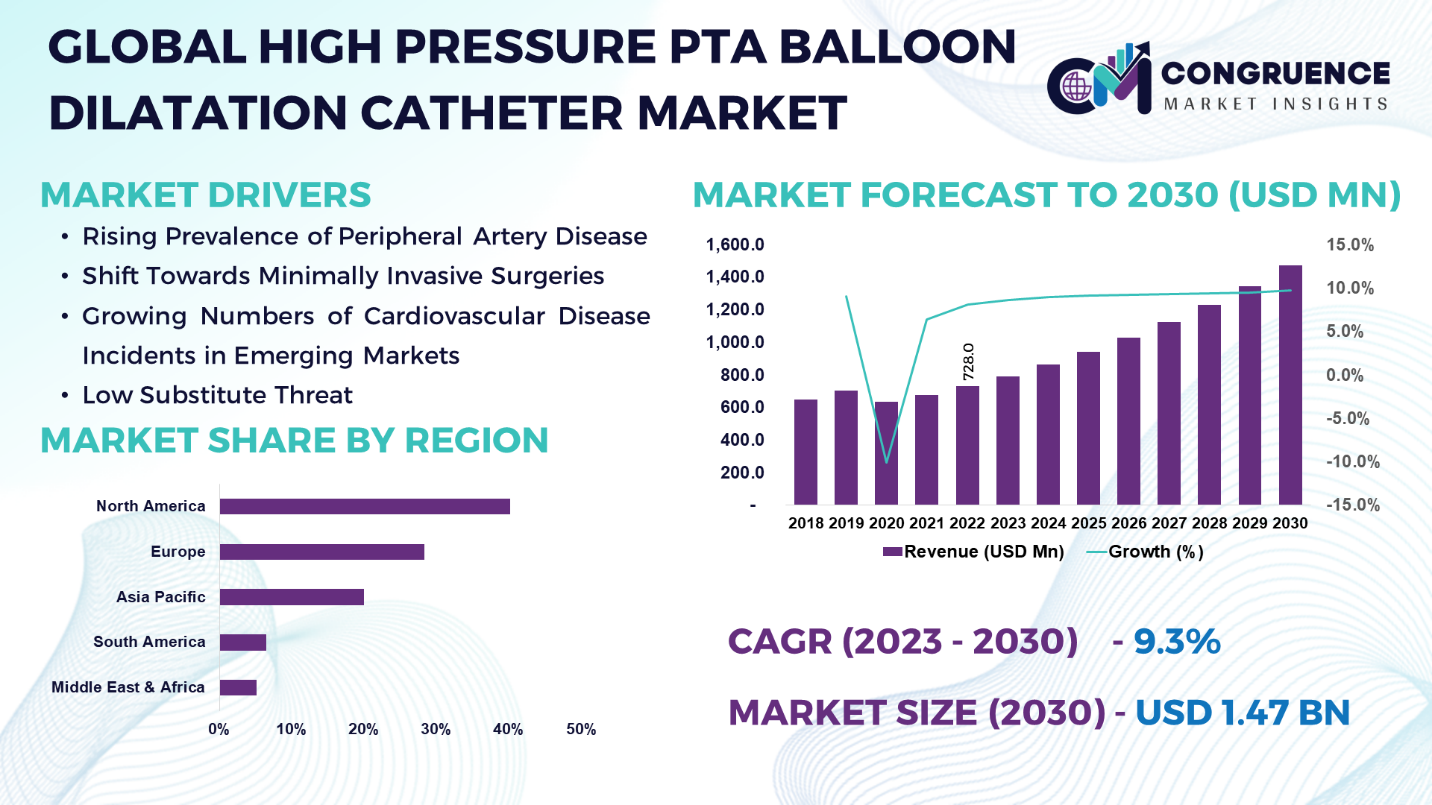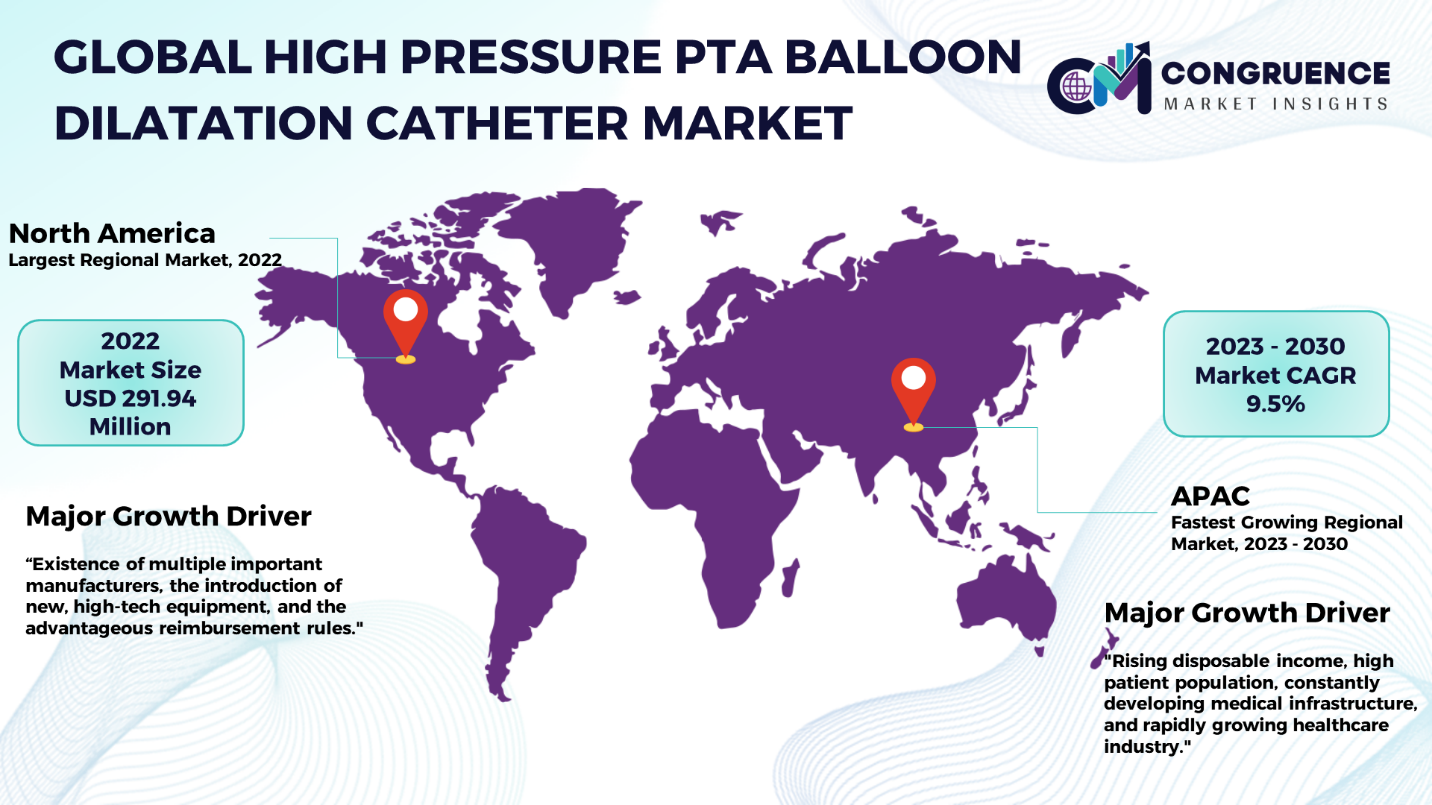Reports
The Global High Pressure PTA Balloon Dilatation Catheter Market was valued at USD 728 Million in 2022 and is anticipated to reach a value of USD 1,473.3 Million by 2030 expanding at a CAGR of 9.3% between 2023 and 2030.
"Percutaneous transluminal angioplasty" is what PTA stands for. An inflating balloon is placed at the tip of the PTA balloon catheter, which is used in a minimally invasive catheterization treatment. The deflated balloon is placed in the constricted area, inflated for a brief while, and then deflated once more in order to be taken out. The capacity to apply substantial radial force sets high-pressure PTA balloon dilatation catheters apart and enables efficient dilatation of hard-to-dile-through lesions and hardened plaques. PTA balloons vary in length, width, and form based on the anatomy they are meant to treat. There are two methods for treating peripheral vascular lesions with PTA balloon catheters. Extending the lumen of a blocked blood artery is one method. This procedure, also referred to as "plain-old balloon angioplasty" (POBA), which involved the expanding of constricted or obstructed blood arteries with a balloon. The implantation of stents to treat vascular blockages is another use for this method.

High Pressure PTA Balloon Dilatation Catheter Market Major Driving Forces
Rising Prevalence of Peripheral Artery Disease: The rising incidence of peripheral artery disease is driving growth in the PTA balloon catheter market (PAD). Globally, the prevalence of PAD, which is defined by arterial constriction, is rising and is linked to aging populations, sedentary lifestyles, and diseases including diabetes and obesity. In minimally invasive techniques to restore blood flow in damaged arteries, PTA balloon catheters play a crucial role. They relieve symptoms of PAD, including leg pain, by blowing up a balloon to expand constricted arteries. In order to address the demands of patients with peripheral artery disease, the market is expanding as a result of a growing demand for PTA balloon catheters.
Shift Towards Minimally Invasive Surgeries: There are multiple reasons behind the transition from open surgery to minimally invasive techniques. These include lower costs, fewer physical injuries and incisions, faster recovery periods, and fewer problems. The market for PTA balloon dilatation catheters at high pressure is being greatly impacted by this trend. Owing to its lower risk, quicker recovery times, less invasiveness, and cost-effectiveness, minimally invasive surgeries are becoming more and more prevalent.
Growing Numbers of Cardiovascular Disease Incidents in Emerging Markets: The rising preference for and affordability of minimally invasive surgeries in emerging markets like Brazil and India, combined with the rising prevalence of cardiovascular diseases, is driving market growth in these regions.
Low Substitute Threat: An additional motivating reason is the minimal threat of substitutes. As of right now, PTA balloon catheters have no meaningful alternatives available on the market. It is perfect for use, leaving little room for alternatives thanks to benefits including rapid inflation, good deliverability, tractability assurance, and expanded treatment reach with longer-length balloons.
High Pressure PTA Balloon Dilatation Catheter Market Key Opportunities
Aging Populations: There is a great deal of room for growth in the market for high-pressure PTA balloon dilatation catheters due to the growing population of elderly people.
Telemedicine and Remote Monitoring: The amalgamation of catheter technology with telemedicine platforms and remote monitoring systems presents prospects for augmenting patient care, optimizing procedural efficiency, and broadening market penetration.
Focus on Emerging Applications: Emphasis on New Applications Examining novel applications that go beyond conventional cardiovascular therapies, notably peripheral vascular and neurovascular operations, offers chances for market expansion and diversification.
High Pressure PTA Balloon Dilatation Catheter Market Key Trends
· The need for high-pressure PTA balloon dilatation catheters is being driven by the growing use of minimally invasive procedures.
· Technological developments resulting in the creation of more adaptable and efficient catheter designs.
· The need for interventional cardiology procedures is being driven by the rising frequency of cardiovascular disorders.
· The need for effective and user-friendly catheter solutions is being driven by the shift towards outpatient settings.
· The need for catheters to treat age-related artery blockages is fueled by an aging population.
· Pay attention to patient-centric solutions, such as enhanced safety features and modified catheter diameters.
· Regulatory harmonization expedites approval procedures and shortens catheter manufacturers' time to market.
· Catheter technology integration with telemedicine platforms to improve patient care and allow for remote monitoring.
· Investigation of novel uses for market diversification that go beyond conventional cardiovascular therapies, including neurovascular operations.
Region-wise Market Insights
North America accounted for the largest market share at 40.1% in 2022 whereas, Asia Pacific is expected to register the fastest growth, expanding at a CAGR of 9.5% between 2023 and 2030.

With a 40.1% market share in 2022, North America led the PTA balloon catheter industry as a whole. This is explained by the existence of multiple important manufacturers, the introduction of new, high-tech equipment, and the advantageous reimbursement rules. The European PTA balloon catheter market is being driven by the increase in the prevalence of diabetes, government initiatives, and the launch of various high-tech devices by prominent manufacturers. With a CAGR of 9.5%, the Asia Pacific region is anticipated to grow at the quickest rate during the projection period. This can be linked to rising healthcare costs and a rise in the prevalence of cardiovascular diseases. According to BioMed Central, cardiovascular disease affects one in five adult Chinese citizens. Additionally, it is anticipated that the aging populations of nations such as China and Japan, along with rising disposable incomes, will propel market rise in the area. The region's market is expanding as a result of the rise of health tourism in emerging countries. Due to its high patient population, constantly developing medical infrastructure, and rapidly growing healthcare industry, China held the greatest share of the PTA balloon catheter market in the Asia Pacific region in 2022.
Market Competition Landscape
There is fierce competition among several manufacturers in the global market for high pressure PTA balloon dilatation catheters. In order to obtain a competitive advantage, major companies in the high pressure PTA balloon dilatation catheter market employ certain techniques. In order to adapt to changing consumer tastes, these methods include product innovation, design distinction, and the use of eco-friendly and sustainable materials. Established companies rely on their quality and dependability reputation to hold onto market share, while more recent competitors concentrate on disruptive technologies and USPs.
Furthermore, the market is rife with strategic alliances, partnerships, and acquisitions that promote innovation, knowledge transfer, and market expansion. Adherence to quality standards and regulatory compliance are critical factors that impact market competitiveness and purchasing decisions. The need for high-quality, reasonably priced catheter solutions is rising as healthcare organizations work to lower costs and enhance patient outcomes. This encourages producers to keep coming up with new ideas and creating cutting-edge catheter technologies that provide increased comfort, safety, and performance. Prominent players in the market include:
· Medtronic plc
· Boston Scientific Corporation
· Abbott Laboratories
· Terumo Corporation
· B. Braun Melsungen AG
· Cook Medical Inc.
· Cordis Corporation (A Cardinal Health Company)
· Cardinal Health, Inc.
· C. R. Bard, Inc. (BD)
· Olympus Corporation
· Johnson & Johnson
· Teleflex Incorporated
· Merit Medical Systems, Inc.
· AngioDynamics, Inc.
· Becton, Dickinson and Company (BD)
|
Report Attribute/Metric |
Details |
|
Market Revenue in 2022 |
USD 728.0 Million |
|
Market Revenue in 2030 |
USD 1,473.3 Million |
|
CAGR (2023 – 2030) |
9.3% |
|
Base Year |
2022 |
|
Forecast Period |
2023 – 2030 |
|
Historical Data |
2018 to 2022 |
|
Forecast Unit |
Value (US$ Mn) |
|
Key Report Deliverable |
Revenue Forecast, Growth Trends, Market Dynamics, Segmental Overview, Regional and Country-wise Analysis, Competition Landscape |
|
Segments Covered |
· By Product Type (Standard Balloon Catheters, Cutting Balloon Catheters, Scoring Balloon Catheters, Drug-Coated Balloon Catheters) · By Material (Polyethylene, Polyurethane, Nylon, Others) · By Application (Peripheral Artery Disease, Coronary Artery Disease, Neurovascular Disease, Others) · By End-User (Hospitals, Ambulatory Surgical Centers, Specialty Clinics, Others) |
|
Geographies Covered |
North America: U.S., Canada and Mexico Europe: Germany, France, U.K., Italy, Spain, and Rest of Europe Asia Pacific: China, India, Japan, South Korea, Southeast Asia, and Rest of Asia Pacific South America: Brazil, Argentina, and Rest of Latin America Middle East & Africa: GCC Countries, South Africa, and Rest of Middle East & Africa |
|
Key Players Analyzed |
Medtronic plc, Boston Scientific Corporation, Abbott Laboratories, Terumo Corporation, B. Braun Melsungen AG, Cook Medical Inc., Cordis Corporation (A Cardinal Health Company), Cardinal Health, Inc., C. R. Bard, Inc. (BD), Olympus Corporation, Johnson & Johnson, Teleflex Incorporated, Merit Medical Systems, Inc., AngioDynamics, Inc., Becton, Dickinson and Company (BD). |
|
Customization & Pricing |
Available on Request (10% Customization is Free) |
